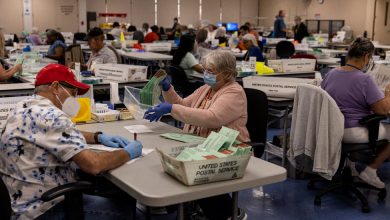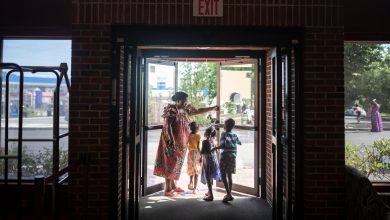Democrats’ Mystery: How to Brighten a Presidency and a National Mood

LAKEWOOD, Ohio — At a Whole Foods in one moderate Cleveland suburb, shoppers recently worried about war, inflation, a “scary” political climate — and a Democratic Party some saw as slow to address the nation’s burning problems.
At a house party for a left-wing congressional candidate across town, attendees fretted over the high cost of living and exorbitant student loan debt as they weighed their choices in Ohio’s primary elections on Tuesday.
And at a campaign event for Representative Shontel Brown here in Lakewood, a liberal city near Cleveland, not everyone seemed impressed by President Biden.
“He’s OK,” allowed Yolanda Pace-Owens, 46, who works in security. She said that she had voted for Mr. Biden and still admired him, but that she was alarmed by a pandemic-era rise in violent crime. “We just got to do better,” she said.
Nearly six months before the midterm elections, Mr. Biden and the Democrats face staggering challenges and signs of dampened enthusiasm among nearly every constituency that powered their 2020 presidential and 2018 midterm victories, according to polls and more than two dozen interviews with voters, elected officials and party strategists across the country.
Yet Democrats are still struggling with how to even discuss the nation’s greatest challenges — much less reach a consensus on how to right the ship.
The party’s problems run deep, as Mr. Biden’s lead pollster has privately warned the White House for months. Independent voters backed Mr. Biden in 2020, but his approval rating with independents now hovers in the 30s. He has underperformed with voters of color in some surveys. Warning signs have emerged among suburban voters. And Mr. Biden’s approval rating has deteriorated with young people even though he won them overwhelmingly in 2020.
In a midterm environment heavily shaped by the president’s approval rating, all of those numbers are gravely worrying for Democratic candidates, who are left with tough questions about how to engage unsettled voters and reinvigorate their base.
How much time should they spend trying to show voters they grasp the pain of inflation, compared with efforts to remind them of low unemployment? Should they pursue ambitious policies that show Democrats are fighters, or is it enough to hope for more modest victories while emphasizing all that the party has passed already?
A Guide to the 2022 Midterm Elections
- Midterms Begin: The 2022 election season is underway. See the full primary calendar and a detailed state-by-state breakdown.
- In the Senate: Democrats have a razor-thin margin that could be upended with a single loss. Here are the four incumbents most at risk.
- In the House: Republicans and Democrats are seeking to gain an edge through redistricting and gerrymandering, though this year’s map is poised to be surprisingly fair
- Governors’ Races: Georgia’s contest will be at the center of the political universe, but there are several important races across the country.
- Key Issues: Inflation, the pandemic, abortion and voting rights are expected to be among this election cycle’s defining topics.
And even when candidates try to tell that story, is anyone listening?
“Voters hear us, but I don’t know that we have convinced voters as to how these things will affect them on a personal level,” Representative James E. Clyburn of South Carolina, the third-ranking House Democrat, said in a recent interview. “We’re not connecting with the voters on the level that they can connect with.”
As Mr. Biden confronts the lingering pandemic, war in Ukraine and historical headwinds — the president’s party typically loses seats in midterm elections — he has acknowledged his party’s messaging challenges, worrying recently that amid crises, “we haven’t sold the American people what we’ve actually done.”
The president, a consummate retail politician who some Democrats had hoped would be more visible, is now pursuing a more robust travel schedule to sell his party’s agenda and accomplishments, and he is highlighting some contrasts with Republicans.
Allies and some voters note that polling is partially driven by anger over extraordinary events, including the war’s impact on gas prices, that the White House could not fully control. But Mr. Biden’s advisers say that the president is working to demonstrate that Democrats understand voters’ struggles and are moving to fix them, as the party’s lawmakers make a fresh push for a range of legislative priorities, especially concerning prices. On Thursday, Mr. Biden also said that he was considering wiping out some student loan debt.
A new Washington Post-ABC poll also showed some positive signs for Mr. Biden and the Democrats, though Republicans retained significant advantages on issues including inflation, the economy and crime.
“While President Biden and Democrats work to lower costs and continue the historic economic recovery made possible by the American Rescue Plan, Republicans have done everything they can to try to stand in the way,” Jaime Harrison, the chairman of the Democratic National Committee, said in a statement.
Yet months of national polls show that Americans have a vastly different perception of the party in power. Even in overwhelmingly liberal Los Angeles, private Democratic polling in April found Mr. Biden’s favorability rating at only 58 percent, according to a person with direct knowledge of the data.
Democratic tensions over messaging have been on display in Ohio, where candidates in this week’s primaries reflect the full spectrum of competing views.
Ms. Brown, who faces a contested primary in a safely Democratic seat and was endorsed by Mr. Biden, is running hard on the bipartisan infrastructure law.
She echoed other House Democrats in promoting the message that “Democrats have been delivering.”
But Biden advisers have privately indicated that pitch tests poorly as a party slogan. And at another Ohio event in late April, Nina Turner, a former state senator who is challenging Ms. Brown from the left in a rematch, suggested that Democrats had not delivered nearly enough.
She urged, among other priorities, universal cancellation of student debt — or, at a minimum, canceling $10,000 in federal student debt per borrower (Ms. Brown also supports some student debt forgiveness measures). Mr. Biden, who endorsed the $10,000 goal in 2020, has postponed payments, and significant student debt has been erased during his tenure, but some have called on him to do much more. He may take further action, and there is still time to make more progress on the Democratic agenda.
But for now, many on the left are disappointed that Democrats, despite controlling Washington, have run aground in the divided Senate on priorities like the climate and voting rights.
“People can forgive you, even if you can’t get something done,” Ms. Turner said. “What they don’t like is when you’re not fighting. And we need to see more of a fighting spirit among the Democratic Party.”
On the other end of the party’s ideological spectrum is Representative Tim Ryan, a moderate Ohio Democrat running for Senate in a state that has veered rightward. He is casting himself as a fighter for the working class and highlighting measures like the infrastructure law, while seeking some cultural and political distance from many others in his party.
In an interview, Mr. Ryan cheered a ruling to eliminate mask mandates on airlines and public transportation, which is now being challenged. “Masks suck,” he said. “I think we’re all tired of it.”
Asked which national Democratic surrogates he would welcome, he cited Senator Sherrod Brown of Ohio, Senator Jon Tester of Montana and Senator Gary Peters of Michigan — but asked specifically about Mr. Biden or Vice President Kamala Harris, Mr. Ryan said: “This is my race. I’m going to be the face of this.” (Biden advisers noted that the president has recently appeared with Democrats in competitive races.)
And as of Friday, Mr. Ryan was one of seven Democratic candidates who have run ads this year that mentioned inflation, according to the media tracking firm AdImpact. By contrast, dozens of Republican candidates and allied groups have done the same. In polls, Americans have cited inflation as a top issue.
“Burying your head in the sand,” Mr. Ryan said, “is not the way to approach it.” Asked about the biggest challenges facing his party, he replied, “A response to the inflation piece is a big hurdle.”
He also cited “a national brand that is not seen as connected to the working-class people, whether they’re white or Black or brown.”
Lou McMahon, a registered Democrat who said he did not vote in the last two presidential elections because he did not like his choices, sounded open to Mr. Ryan in an interview at Ms. Brown’s event. But asked to assess Democrats in Washington generally, he replied, “Promise, but not delivered,” citing both stalled legislative ambitions and Mr. Biden’s pledge to help heal partisan divisions.
“The targets and the aspirations were maybe beyond the reach,” said Mr. McMahon, 58, an environmental lawyer. “The reuniting that was so much of the promise hasn’t played out in reality quite that way.”
Celinda Lake, a veteran Democratic strategist and a pollster on Mr. Biden’s 2020 campaign, said that “there’s nobody in America more deeply disappointed in how divided America is than Joe Biden.”
“He does communicate it, but I think it helps a lot when he’s on the road,” she said.
Republicans face their own midterm difficulties. Many candidates have adopted former President Donald J. Trump’s relentless focus on the false notion of a stolen 2020 election, a stance that swing voters may dismiss as extreme. In some primaries, the party runs the risk of nominating seriously flawed general-election candidates.
Democratic officials hope their prospects will brighten as primary contests are settled and candidates draw sharper direct contrasts with their opponents — and they are already trying to define that choice.
On one side, they say, are bomb-throwing Republicans who are caught up in cultural battles, fealty to Trumpism and a controversial tax and social safety net proposal. On the other, Democrats argue, is a party that passed major infrastructure and pandemic relief measures, and spearheaded the confirmation of the first Black woman to the Supreme Court. Mr. Biden has also moved to combat gun violence, confronting Republican efforts to portray Democrats as weak on crime.
Many Democratic candidates are also raising vast sums of money, a sign of voter engagement.
“Our members have a great record of results, and the other side is offering nothing except anger and fear,” said Representative Sean Patrick Maloney of New York, the chair of the House Democratic campaign arm. “My message is: We’re getting good things done. We’re part of the solution. Give us a little more time.”
Time indeed remains, and Democrats could reverse their fortunes in an unpredictable environment — but it is also possible that in the fall, the outlook will be largely unchanged.
“The problem with midterm elections is, they’re not really a choice,” said David Axelrod, who served as a senior adviser to former President Barack Obama. “They tend to be a referendum on the party that controls the White House.”



